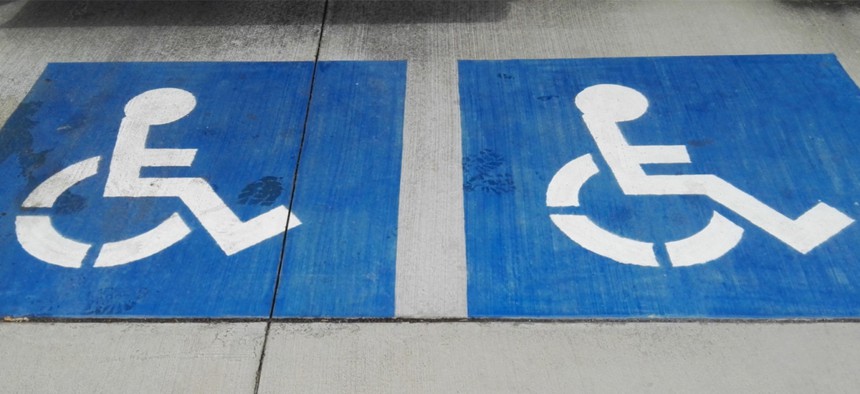States Helping Disabled Students Move to Work Despite Unclear Federal Funding, Report Says

In fiscal year 2016, states reported spending roughly $357 million out of a reserved $465 million, according to federal data. shutterstock

Connecting state and local government leaders
There's widespread confusion over which programs are reimbursable, according to the federal Government Accountability Office.
State-level vocational rehabilitation agencies are expanding services to help disabled students transition from high school to work in spite of federal guidelines that make it unclear which programs are eligible for reimbursement, according to a recent report from the federal Government Accountability Office.
In fiscal year 2016, states reported spending roughly $357 million out of a reserved $465 million, according to federal data.
“States had difficulty determining what expenditures were allowable, and some state officials said they would like more detailed information from (the federal Department of Education),” the report says. “Education officials said they plan to clarify guidance but have no timeframe for providing further information, which would help states to better plan their use of reserved funds.”
State vocational rehabilitation agencies are tasked with helping disabled residents, including students, meet their employment goals. Recent changes to federal policy required states to “additionally provide a defined set of activities called pre-employment transition services” to an expanded pool of students.
Those services—including job exploration counseling and work-based learning experiences like internships—are designed to help students identify their career interests. Programs must be made available to all students with disabilities, regardless of whether they’ve applied for eligibility.
States have expanded services “by either serving more students through pre-employment transition services or by initiating new or additional services,” according to the report. In Maryland, for example, officials added services after school and during the summer, including opportunities for students to meet with employers. In Idaho, officials began developing new programming and instruction aimed at serving larger groups and providing other services, including paid work experience.
The biggest increase was among self-advocacy programs, including “classroom lessons in which students learn about their rights, responsibilities, and how to request accommodations or services and supports needed during transition.”
State officials told GAO employees that the process has allowed them to provide services to more students with disabilities at a younger age, “which will likely have positive effects on students’ transition from school to work.”
“For example, officials in one discussion group noted that the provision of pre-employment transition services is increasing awareness, enhancing services, and increasing the likelihood that VR program outcomes will improve,” the report says. “In another discussion group, officials said their agencies had already seen benefits from pre-employment transition services and the services have raised students’ expectations for the types of jobs they might obtain.”
But the expansion comes with challenges, state officials noted. In fiscal year 2016, just 21 of 56 areas (50 states, five territories and the District of Columbia) reported using the full amount of grant funds reserved for pre-employment transition services.
The report notes several reasons for the shortfall. Federal funds can’t be used to pay for some services, including transportation (getting disabled students to and from counseling sessions, for example) and tuition. Sometimes state officials are simply unclear which services are eligible for reimbursement, which federal education agencies said is a fairly common problem. There is communication between the two levels of government, but it’s often ineffective, the report notes.
“Education communicated with states on broad requirements but provided little detailed information directly to states on the allowable use of funds reserved for pre-employment transition services,” it says. Federal officials provided information in a variety of formats, but each “described activities on which states could not spend funds, but provided little detailed information on what expenditures are allowed.”
State officials said they could use a list of best practices from the federal Department of Education to address challenges, specifically guidance on coordinating with state agencies, balancing pre-employment transition services with other vocational rehabilitation programs, collecting data and updating data tracking systems. Education officials said they planned to compile that list but don’t have ”a final written plan for managing these efforts because plans are still under discussion in light of inquiries received.” To start the process, federal officials hope to monitor practices at the state level, but a comprehensive summary of those efforts is not expected until the end of fiscal year 2021.
Without a clearer timeframe for federal guidance, states may miss opportunities to provide services to eligible students, “and unserved students could continue to face difficulties preparing for a future of meaningful post-secondary education or employment,” the report says.
To combat the program, the GAO recommends that the federal education department establish timeframes for providing states with information on allowable expenditures, help states coordinate with state-level educational agencies and “develop a written plan with specific timeframes and activities for identifying and disseminating best practices.”
Kate Elizabeth Queram is a Staff Correspondent for Government Executive’s Route Fifty and is based in Washington, D.C.

NEXT STORY: North Dakota looks to Drupal for improved user experience




